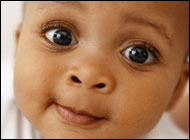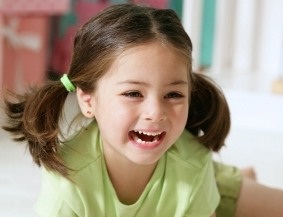Bilingual babies’ vocabulary linked to early brain differentiation
Babies and children are whizzes at learning a second language, but that ability begins to fade as early as their first birthdays.
Researchers at the University of Washington’s Institute for Learning & Brain Sciences are investigating the brain mechanisms that contribute to infants’ prowess at learning languages, with the hope that the findings could boost bilingualism in adults, too.
In a new study, the researchers report that the brains of babies raised in bilingual households show a longer period of being flexible to different languages, especially if they hear a lot of language at home. The researchers also show that the relative amount of each language – English and Spanish – babies were exposed to affected their vocabulary as toddlers.
The study, published online Aug. 17 in Journal of Phonetics, is the first to measure brain activity throughout infancy and relate it to language exposure and speaking ability.
“The bilingual brain is fascinating because it reflects humans’ abilities for flexible thinking – bilingual babies learn that objects and events in the world have two names, and flexibly switch between these labels, giving the brain lots of good exercise,” said Patricia Kuhl, co-author of the study and co-director of the UW’s Institute for Learning & Brain Sciences.
Kuhl’s previous studies show that between 8 and 10 months of age, monolingual babies become increasingly able to distinguish speech sounds of their native language, while at the same time their ability to distinguish sounds from a foreign language declines. For instance, between 8 and 10 months of age babies exposed to English become better at detecting the difference between “r” and “l” sounds, which are prevalent in the English language. This is the same age when Japanese babies, who are not exposed to as many “r” and “l” sounds, decline in their ability to detect them.
 “The infant brain tunes itself to the sounds of the language during this sensitive period in development, and we’re trying to figure out exactly how that happens,” said Kuhl, who’s also a UW professor of speech and hearing sciences. “But almost nothing is known about how bilingual babies do this for two languages. Knowing how experience sculpts the brain will tell us something that goes way beyond language development.”
“The infant brain tunes itself to the sounds of the language during this sensitive period in development, and we’re trying to figure out exactly how that happens,” said Kuhl, who’s also a UW professor of speech and hearing sciences. “But almost nothing is known about how bilingual babies do this for two languages. Knowing how experience sculpts the brain will tell us something that goes way beyond language development.”
In the current study, babies from monolingual (English or Spanish) and bilingual (English and Spanish) households wore caps fitted with electrodes to measure brain activity with an electroencephalogram, or EEG, a device that records the flow of energy in the brain. Babies heard background speech sounds in one language, and then a contrasting sound in the other language occurred occasionally.
 For example, a sound that is used in both Spanish and English served as the background sound and then a Spanish “da” and an English “ta” each randomly occurred 10 percent of the time as contrasting sounds. If the brain can detect the contrasting sound, there is a signature pattern called the mismatch response that can be detected with the EEG.
For example, a sound that is used in both Spanish and English served as the background sound and then a Spanish “da” and an English “ta” each randomly occurred 10 percent of the time as contrasting sounds. If the brain can detect the contrasting sound, there is a signature pattern called the mismatch response that can be detected with the EEG.
Why it’s great to be bilingual
- Learning both parents’ languages from the beginning allows children to communicate with extended family members, from stronger bonds, and develop a cultural identity.
- The ability to speak another language fluently gives a child access to different cultures and perspectives.
- Knowing the language of her parents is an important part of a child’s cultural identity and sense of belonging.
- Research By Dr Hakuta from Stanford University indicates that people who speak more than one language have a greater ability to understand and analyse concepts because they have more than one language system to rely on.
Tips for biligual families
Start early: The easiest way to learn language is right from birth. In the same way as children learn one language without even being conscious of the learning process, they can learn two languages. The human brain is much more capable of learning before the age of 10.
Keep languages separate: Most researchers believe that it is best for children to hear a relatively pure language, rather than a mixture of the two, so they can distinguish the languages from each other. Some families do this quite naturally, with each parent speaking his or her own language to the baby. The child learns easily and naturally which words belong together. She will probably mix the languages initially, but as she grows more proficient, she will tend to separate them more effectively. The most important advice language teaching experts give parents is to be consistent on this point, and to provide sufficient exposure to both language on an on-going basis.
Punt the “second” language: If one language is dominant, for instance, if your family lives in a pre-dominantly English-environment, and you wish to introduce her to a more unusual language, like Japanese, it may be hard to make sure the secondary language gets reasonable exposure. The child will hear English spoken on television, in shops, in playschool and amongst friends, and might tend to forego the “second” language.
In this case, it is particularly important that the parent who speaks the second language communicates with the child in that language as much as possible. Give her books, songs, tapes and videos that will reinforce the language and the culture. See if you can find a cre`che or preschool where that language is spoken. If you know other moms trying to bring up children in a bilingual way, get together for play dates so your baby has a chance to communicate in that language with her peers.
Value the “second” language: If English is so dominant as she grows up, your child might not view the second language as particularly valuable or important. She might wonder what the point is of learning anything other than English. She might even go through a stage where anything that marks her as different or unusual – like speaking a “funny” language – is something to hide.
One way to overcome this is to show her positive aspects of the other language and culture. If it is at all possible, expose her to a wider community of extended family members, friends, other children, community or other church groups who speak that language. To have the opportunity to experience and be part of two different cultures is a real advantage – encourage her to enjoy and explore all aspects of her cultural heritage.
Monolingual babies at 6-9 months of age showed the mismatch response for both the Spanish and English contrasting sounds, indicating that they noticed the change in both languages. But at 10-12 months of age, monolingual babies only responded to the English contrasting sound.
Bilingual babies showed a different pattern. At 6-9 months, bilinguals did not show the mismatch response, but at 10-12 months they showed the mismatch for both sounds.
This suggests that the bilingual brain remains flexible to languages for a longer period of time, possibly because bilingual infants are exposed to a greater variety of speech sounds at home.
This difference in development suggests that the bilingual babies “may have a different timetable for neurally committing to a language” compared with monolingual babies, said Adrian Garcia-Sierra, lead author and a postdoctoral researcher at UW’s Institute for Learning & Brain Sciences.
“When the brain is exposed to two languages rather than only one, the most adaptive response is to stay open longer before showing the perceptual narrowing that monolingual infants typically show at the end of the first year of life,” Garcia-Sierra said.
To see if those brain responses at 10-12 months related to later speaking skills, the researchers followed up with the parents when the babies were about 15 months old to see how many Spanish and English words the children knew. They found that early brain responses to language could predict infants’ word learning ability. That is, the size of the bilingual children’s vocabulary was associated with the strength of their brain responses in discriminating languages at 10-12 months of age.
Early exposure to language also made a difference: Bilingual babies exposed to more English at home, including from their parents, other relatives and family friends, subsequently produced more words in English. The pattern held true for Spanish.
The researchers say the best way for children to learn a second language is through social interactions and daily exposure to the language.
“Learning a second language is like learning a sport,” said Garcia-Sierra, who is raising his two young children as bilingual. “The more you play the better you get.”
###
Co-authors are Maritza Rivera-Gaxiola, formerly a UW research scientist; Cherie Percaccio, a postdoctoral researcher and Lindsay Klarman, a research technician at the UW Institute for Learning & Brain Sciences; Barbara Conboy, a speech-language pathologist at the University of Redlands; and Harriett Romo, director, and Sophia Ortiz, assistant director, of the Child & Adolescent Policy Research Center at the University of Texas at San Antonio.
The National Science Foundation Science of Learning Program grant to the UW’s LIFE Center, a multi-institutional program, funded the study.
For more information, contact Kuhl at 206-685-1921 .(JavaScript must be enabled to view this email address) or Garcia-Sierra at 206-221-6415 or .(JavaScript must be enabled to view this email address).
###
Contact: Molly McElroy
.(JavaScript must be enabled to view this email address)
206-543-2580
University of Washington